You can Download KSEEB Solutions for Class 8 Science Chapter 15 Some Natural Phenomena Questions and Answers Pdf, Notes help you to revise the complete syllabus.
KSEEB Solutions for Class 8 Science Chapter 15 Some Natural Phenomena
Some Natural Phenomena Textbook Questions and Answers
Select the correct option in Questions 1 and 2.
Question 1.
Which of the following cannot be changed easily by friction?
(a) A plastic scale.
(b) A copper rod.
(c) An inflated balloon.
(d) A woolen cloth.
Answer:
(b) A copper rod.
![]()
Question 2.
When a glass rod is rubbed with a piece of silk cloth the rod.
(a) and the cloth both acquire a positive charge.
(b) becomes positively charged while the cloth has a negative charge.
(c) and the cloth both acquire a negative charge.
(d) becomes negatively charged while the cloth has a positive charge.
Answer:
(b) Becomes positively charged while the cloth has a negative charge.
Question 3.
Write T against true and F against false in the following statements:
- Like charges attract each other. (T/F)
- A charged glass rod attracts a charged plastic straw. (T/F)
- The lightning conductor cannot protect a building from lightning. (T/F)
- Earthquakes can be predicted in advance. (T/F)
Answer:
- Like charges attract each other. (F)
- A charged glass rod attracts a charged plastic straw. (T)
- The lightning conductor cannot protect a building from lightning. (F)
- Earthquakes can be predicted in advance. (F)
Question 4.
Sometimes, a crackling sound is heard while taking off a sweater during winters. Explain.
Answer:
The crackling sound is heard because when the sweater is rubbed with the skin while taking it off, it acquires a small charge. Due to this charge, a crackling sound is heard. This event is like lightning.
![]()
Question 5.
Explain why a charged body loses its charge if we touch it with our hand.
Answer:
When we touch a charged body, it loses its charge, due to the process of earthing. Our body is good conductor of electricity and transfers the charges to the earth.
Question 6.
Name the scale on which the destructive energy of an earthquake is measured. An earthquake measures 3 on this scale. Would it be recorded by a seismograph? Is it likely to cause much damage?
Answer:
The destructive energy of an earthquake is measured in Richter Scale. Yes, it will be recorded on this scale. An earthquake with a magnitude of 3 on the Richter Scale is not much destructive.
Question 7.
Suggest three measures to protect ourselves from lightning.
Answer:
- Hearing thunder, we should rush to a safer place like a house or building.
- If no proper shelter is available and we are in an open field then he/she should stay away from trees, poles and other metal objects. We should not lie on the ground, instead, squal low on the ground i.e., a position where hands are put on knees with head between the hands.
- If we are inside the house, telephone cords, electrical wires, and metal pipes should be avoided. Bathing should also be avoided to avoid contact with running water.
![]()
Question 8.
Explain why a charged balloon is repelled by another charged balloon whereas an uncharged balloon is attracted by another charged balloon?
Answer:
A charged balloon is repelled by another charged balloon because both have the same charge. And we know similar charges repel each other. But a charged balloon attracts an uncharged balloon and loses its own charge to the other balloon.
Question 9.
Describe with the help of a diagram an instrument which can be used to detect a charged body.
Answer:
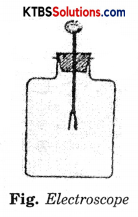
An electroscope can be used to detect if a body is charged or not. When the metal strips repel each other proves that the body is charged as repulsion is the sure test to detect if a body carries charge or not.
Question 10.
List three states in India where earthquakes are more likely to strike.
Answer:
Kashmir, Punjab, Rajasthan, and Gujarat are more prone to earthquakes.
Question 11.
Suppose you are outside your home and an earthquake strikes. What precaution would you take to protect yourself?
Answer:
We will take the following precautions:
- We will try to move to an open space.
- If we are driving, we will slow down the vehicle and move slowly away from that area.
- We will not take shelter under trees or buildings.
![]()
Question 12.
The weather department has predicted that a thunderstorm is likely to occur on a certain day. Suppose you have to go out on that day. Would you carry an umbrella? Explain.
Answer:
No, I would not carry an umbrella because it is not safe. The pointed rod of the umbrella can become a target of lightning because it is made of metal.
Some Natural Phenomena Additional Questions and Answers
Question 1.
What is Lightning? How is it caused?
Answer:
Lightning is an electric spark but on a huge scale.
Lightning is caused by the accumulation of charges in the clouds.
Question 2.
What is the meaning of objects getting charged or they carry an electric charge?
Answer:
Some things after being rubbed with other things develop a property by which they can attract small bits of paper. This is an object getting charged or they carry an electric charge.
![]()
Question 3.
The charged objects continue to attract bits of paper for some time. Why does this happen?
Answer:
The reason certain objects get charged is due to static electricity.
Question 4.
Explain the process of lightning:
Answer:
During the development of a thunderstorm, the air currents move upward while the water droplets move downward. These vigorous movements cause the separation of charges. By a process, the positive charges collect near the upper edges of the clouds and the negative charges accumulate near the lower edges. There is an accumulation of positive charges near the ground also. When the magnitude of the accumulated charges becomes very large, the air which is normally a poor conductor of electricity is no longer able to resist their flow. Negative and positive charges meet, producing streaks of bright light and sound. We see streaks as lightning (Fig.). The process is called an electric discharge.
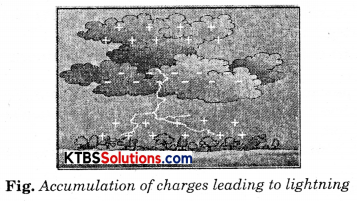
Question 5.
What are lightning conductors?
Answer:
A lightning conductor is a device used to protect buildings from the effect of lightning.
![]()
Question 6.
How are lightning conductors installed in buildings?
Answer:
A metallic rod, taller than the building, is installed in the walls of the building during its construction. One end of the rod is kept out in the air and the other is buried deep in the ground (Fig.). The rod provides an easy route for the transfer of electric charge to the ground. The metal columns used during construction, electrical wires, and water pipes in the buildings also protect us to an extent.
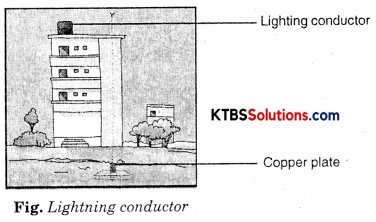
Question 7.
What is an earthquake?
Answer:
An earthquake is a sudden shaking or trembling of the earth which lasts for a very short time. It is caused by a disturbance deep inside the earth’s crust.
Question 8.
What are the effects of earthquakes?
Answer:
Earthquakes can cause immense damage to buildings, bridges, dams, and people. There can be a great loss to life and property. Earthquakes can cause floods, landslides, and tsunamis.
![]()
Activities
Activity 1.
Collect the objects and the materials listed in Table 15.1. Try to charge each by rubbing with the materials mentioned in the Table. Record your findings. You can add more items to the Table.
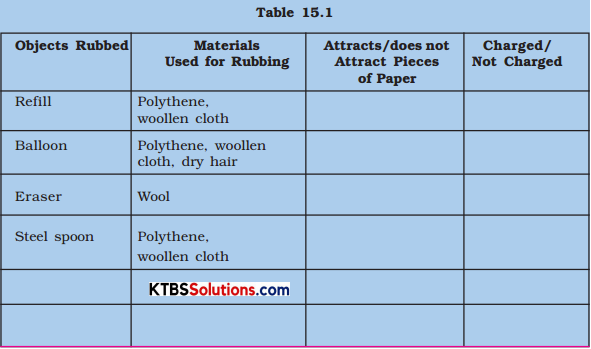
Answer:
Table 15.1
| Objects Rubbed | Materials used for Rubbing | Attracts/does not Attract pieces of paper | Charged/ Not Charged |
| Refill | Polythene, woolen cloth | Attracts | Charged |
| Balloon | Polythene, woolen cloth, dry hair | Attracts | Charged |
| Eraser | Wool | Attracts | Charged |
| Steel spoon | Polythene, woolen cloth | Attracts | Charged |
| Plastic scale | Hair | Attracts | Charged |
| Coin | Woolen cloth | Attracts | Charged |
Activity 2.
(a) Inflate two balloons. Hang them in such a way that they do not touch each other (Fig.). Rub both the balloons with a woollen cloth and release them.
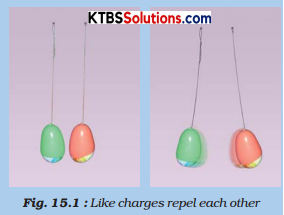
Question (i).
What do you observe?
Answer:
Balloons repel each other.
Now let us repeat this activity with the used pen refills. Rub one refill polythene. Place it carefully in a glass tumbler using the tumbler as a stand (Fig.).

Rub the other refill also with polythene. Bring it close to the charged refill. Be careful not to touch the charged end with your hand.
Question (ii).
Is there any effect on the refill in the tumbler? Do the two attract each other, or repel each other?
Answer:
Yes, Both these refills repel each other.
![]()
Question (iii).
Rub a refill and place it gently in a glass tumbler as before (Fig.). Bring an inflated charged balloon near the refill and observe.

Answer:
They attract each other.
Activity 3.
Take an empty jam bottle. Take a piece of cardboard slightly bigger in size than the mouth of the bottle. Pierce a hole in it so that a metal paper clip can be inserted. Open out the paper clip as shown in Fig. Cut two strips of aluminium foil about 4 cm x 1 cm each. Hang them on the paper clip as shown. Insert the paper clip in the cardboard lid so that it is perpendicular to it (Fig.). Charge a refill and touch it with the end of the paper clip.
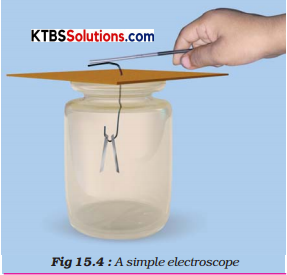
Question (i).
Observe what happens. Is there any effect on the foil strips?
Answer:
Yes. The strips become wide open.
Question (ii).
Do they repel each other or attract each other?
Answer:
Yes. Now, touch other charged bodies with the end of the paper clip.
Question (iii).
Do foil strips behave in the same way in all cases?
Answer:
Yes.
![]()
Question (iv).
Can this apparatus be used to detect whether a body is charged or not?
Answer:
Yes, it can be. Such a device is known as an electroscope.
Question (v).
Can you explain why the foil strip repels each other?
Answer:
The two paper strips acquire the same charges and that is why they repel each other as we know that similar charges repel each other.